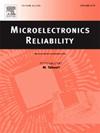离散碳化硅电力电子中铝键合线的几何驱动失效寿命分析
IF 1.9
4区 工程技术
Q3 ENGINEERING, ELECTRICAL & ELECTRONIC
引用次数: 0
摘要
随着器件小型化的发展和对性能要求的提高,键合线的可靠性仍然是电力电子领域面临的主要挑战之一。失效物理模型通常用于确定线键互连的寿命,依赖于通常基于建模假设的有限元模型得出的损伤指标,特别是在处理模压封装时。这些传统的方法忽略了粘结脚和封装腔的实际几何形状的影响。本文采用有源功率循环试验对SiC功率器件中封装铝键合线的可靠性进行了研究。结合线材料在不同的应变速率和温度下具有特征,而其几何形状是使用高分辨率白光干涉测量法测量的。采用两阶段仿真方法对有限元模型进行求解:首先进行上游焊线仿真,获得真实的焊脚和模腔几何形状,然后进行有功功率循环试验仿真。利用仿真结果得出的损伤量对Coffin-Manson寿命模型进行了标定,并分析了不同粘结脚几何形状对寿命的影响。结果表明,建模的键脚几何形状可以显著影响寿命预测。通过解决传统简化模型的局限性,该方法提供了更准确的预测。所提出的方法的目的是在鲁棒仿真模型的帮助下加速汽车应用ecu的设计,减少实验工作量并最终缩短上市时间。本文章由计算机程序翻译,如有差异,请以英文原文为准。
Geometry-driven physics-of-failure lifetime analysis of aluminum bonding wires in discrete SiC power electronics
Bonding wire reliability remains one of the major challenges in power electronics as device miniaturization progresses and demands on performance increase. Physics-of-failure models are commonly formulated to determine the lifetime of wire bond interconnects, relying on damage metrics derived from finite element models often based on modeling assumptions, especially when dealing with molded packages. These conventional approaches neglect the effect of the actual geometries of the bond foot and encapsulation cavity.
In this work, the reliability of encapsulated Al bonding wires in SiC power devices is investigated using active power cycling tests. The bonding wire material is characterized across various strain rates and temperatures, while its geometry is measured using high-resolution white light interferometry. Finite element models are solved using a two-stage simulation approach: First, an upstream wire bonding simulation is performed to obtain realistic bond foot and mold cavity geometries, and then the active power cycling tests are simulated. A Coffin–Manson lifetime model is calibrated using damage quantities derived from the simulation results, and the effect of various bond foot geometries on lifetime is analyzed. The results demonstrate that the modeled bond foot geometry can significantly influence lifetime predictions. By addressing the limitations of conventional simplified models, the presented approach offers a more accurate prediction.
The aim of the presented methodology is to accelerate the design of ECUs for automotive applications with the help of robust simulation models, reducing the experimental effort and ultimately the time to market.
求助全文
通过发布文献求助,成功后即可免费获取论文全文。
去求助
来源期刊

Microelectronics Reliability
工程技术-工程:电子与电气
CiteScore
3.30
自引率
12.50%
发文量
342
审稿时长
68 days
期刊介绍:
Microelectronics Reliability, is dedicated to disseminating the latest research results and related information on the reliability of microelectronic devices, circuits and systems, from materials, process and manufacturing, to design, testing and operation. The coverage of the journal includes the following topics: measurement, understanding and analysis; evaluation and prediction; modelling and simulation; methodologies and mitigation. Papers which combine reliability with other important areas of microelectronics engineering, such as design, fabrication, integration, testing, and field operation will also be welcome, and practical papers reporting case studies in the field and specific application domains are particularly encouraged.
Most accepted papers will be published as Research Papers, describing significant advances and completed work. Papers reviewing important developing topics of general interest may be accepted for publication as Review Papers. Urgent communications of a more preliminary nature and short reports on completed practical work of current interest may be considered for publication as Research Notes. All contributions are subject to peer review by leading experts in the field.
 求助内容:
求助内容: 应助结果提醒方式:
应助结果提醒方式:


